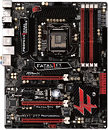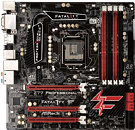- Joined
- Oct 9, 2007
- Messages
- 47,235 (7.55/day)
- Location
- Hyderabad, India
| System Name | RBMK-1000 |
|---|---|
| Processor | AMD Ryzen 7 5700G |
| Motherboard | ASUS ROG Strix B450-E Gaming |
| Cooling | DeepCool Gammax L240 V2 |
| Memory | 2x 8GB G.Skill Sniper X |
| Video Card(s) | Palit GeForce RTX 2080 SUPER GameRock |
| Storage | Western Digital Black NVMe 512GB |
| Display(s) | BenQ 1440p 60 Hz 27-inch |
| Case | Corsair Carbide 100R |
| Audio Device(s) | ASUS SupremeFX S1220A |
| Power Supply | Cooler Master MWE Gold 650W |
| Mouse | ASUS ROG Strix Impact |
| Keyboard | Gamdias Hermes E2 |
| Software | Windows 11 Pro |
ASRock is working on not one, but two motherboard models based on the Intel Z77 chipset, under its Fatal1ty Professional series. The first of the lot is a standard-ATX Z77 Fatal1ty Professional, followed by the micro-ATX Z77 Fatal1ty Professional-M. The latter is ASRock's first micro-ATX Fatal1ty motherboard. The ATX Z77 Fatal1ty Professional could go on to be ASRock's flagship Z77 motherboard. The LGA1155 socket is powered by a 20+ phase digital-PWM power circuitry, and memory by a 5-phase VRM, which make this board as much an overclockers' choice as gamers'.
Expansion slots include two each of PCI-Express 3.0 x16 (x8/x8 when both populated), PCIe 2.0 x1, and legacy PCI; and one PCI-Express 2.0 x16 (electrical x4, wired to the PCH). There are plenty of SATA ports, including six SATA 6 Gb/s (two from the PCH, four from additional controllers), four internal SATA 3 Gb/s, and eSATA. ASRock seems to have deployed a PCIe bridge chip to yield more PCIe lanes. USB 3.0 connectivity includes two ports via front-panel header, and possibly four ports (if not more) on the rear-panel. Since users of this board will almost certainly be using discrete graphics, display connectivity is reduced to smaller ports (such as HDMI or DisplayPort).


The Z77 Fatal1ty Professional-M, on the other hand, has a compacted layout. The CPU is powered by a simpler 11-phase VRM, and memory with 2+1 phase. Expansion slots include two PCI-Express 3.0 x16 (x8/x8 when both populated), one PCI-Express 2.0 x16 (electrical x4), and a PCIe x1. SATA connectivity includes four each of SATA 6 Gb/s, SATA 3 Gb/s, and eSATA 6 Gb/s. It doesn't look like the board is using any third-party USB 3.0 controllers, and instead relying on the four ports the Z77 PCH provides (two via front-panel header, two on the rear-panel). Display connectivity on this board includes DVI and D-Sub, apart from HDMI (probably).
Both models feature ASRock-exclusives such as XFastUSB (higher bandwidth, polling rate), XFastLAN (lower latencies), XFastRAM (quicker troubleshooting of stubborn RAM), and graphics technologies such as NVIDIA SLI, AMD CrossFire, and Lucid VirtuMVP. The two are expected to be a part of the first wave of Z77 motherboards. The two will be shown to the public at CeBIT.
View at TechPowerUp Main Site
Expansion slots include two each of PCI-Express 3.0 x16 (x8/x8 when both populated), PCIe 2.0 x1, and legacy PCI; and one PCI-Express 2.0 x16 (electrical x4, wired to the PCH). There are plenty of SATA ports, including six SATA 6 Gb/s (two from the PCH, four from additional controllers), four internal SATA 3 Gb/s, and eSATA. ASRock seems to have deployed a PCIe bridge chip to yield more PCIe lanes. USB 3.0 connectivity includes two ports via front-panel header, and possibly four ports (if not more) on the rear-panel. Since users of this board will almost certainly be using discrete graphics, display connectivity is reduced to smaller ports (such as HDMI or DisplayPort).


The Z77 Fatal1ty Professional-M, on the other hand, has a compacted layout. The CPU is powered by a simpler 11-phase VRM, and memory with 2+1 phase. Expansion slots include two PCI-Express 3.0 x16 (x8/x8 when both populated), one PCI-Express 2.0 x16 (electrical x4), and a PCIe x1. SATA connectivity includes four each of SATA 6 Gb/s, SATA 3 Gb/s, and eSATA 6 Gb/s. It doesn't look like the board is using any third-party USB 3.0 controllers, and instead relying on the four ports the Z77 PCH provides (two via front-panel header, two on the rear-panel). Display connectivity on this board includes DVI and D-Sub, apart from HDMI (probably).
Both models feature ASRock-exclusives such as XFastUSB (higher bandwidth, polling rate), XFastLAN (lower latencies), XFastRAM (quicker troubleshooting of stubborn RAM), and graphics technologies such as NVIDIA SLI, AMD CrossFire, and Lucid VirtuMVP. The two are expected to be a part of the first wave of Z77 motherboards. The two will be shown to the public at CeBIT.
View at TechPowerUp Main Site
Last edited:

 crossfire action
crossfire action 
 .
.

